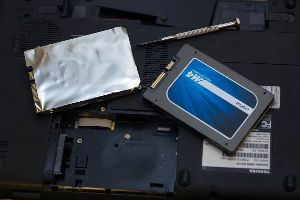New Life for Your Older Computer
The first thing you notice about a solid-state drive (SSD) is its packaging. Disk drives that depend on spinning platters and tiny read-write heads that fly microns above the surface are amazingly rugged now, but they're shipped inside a padded box that's inside another box with additional packing materials. Not so SSDs. They're just tossed into a padded UPS or FedEx bag and shipped. The interior box has a bit of protection but nowhere near what you'd expect with a standard drive. That's because the drive has no moving parts.
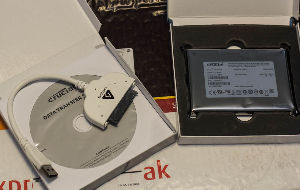 That's what makes it so fast. Because a solid-state drive is really just a lot of memory, it's more expensive than a standard drive. Nothing moves, so effectively whatever "sector" the drive needs to find is directly under the read-write head all the time. There's no need to position read-write heads; instead, the controller software just refers to the location in memory where the needed data is located.
That's what makes it so fast. Because a solid-state drive is really just a lot of memory, it's more expensive than a standard drive. Nothing moves, so effectively whatever "sector" the drive needs to find is directly under the read-write head all the time. There's no need to position read-write heads; instead, the controller software just refers to the location in memory where the needed data is located.
That's also what makes it so rugged. A couple of things could kill an SSD: I think a large hammer would be effective, but it would probably take a few whacks to do it, and some misplaced static electricity. Otherwise, with no moving parts, there's nothing to wear out and no heads will ever come into contact with a disk spinning at 7500 RPM.
Speeding a Toshiba Satellite M645
This is a notebook computer that I bought several years ago. The Satellite series is a good middle-of-the-road group of computers. They're not the fastest computers that Toshiba makes. Nor are they the smallest and lightest. They're small enough to carry, large enough to have a good keyboard, powerful enough to run power-hungry applications such as Photoshop (in a pinch), and good for presentations.
The boot time under Windows 8 is faster than under Windows 7 but I've become spoiled by the 15-second boot time offered by a Windows 8 tablet and the short startup time that my desktop computer has by virtue of its solid-state boot drive (the hundreds of thousands of files still live on standard disk drives because I'm not interested in trying to duplicate the national debt by purchasing SSDs for everything.)
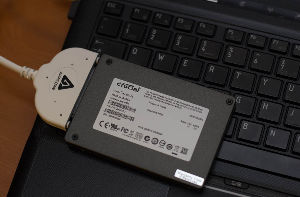 I ordered the drive from Crucial on a Tuesday and paid a few dollars extra for 3-day shipping, assuming it would be in my possession on Friday. What Crucial's website doesn't say as part of the checkout process is that they get an extra day to prepare the order for shipping so 3-day shipping made the delivery day Monday. If only they'd mentioned that on the checkout page, I would have decided either to pay (literally) another couple of dollars to have it on Friday so that I could have the weekend to make the switch.
I ordered the drive from Crucial on a Tuesday and paid a few dollars extra for 3-day shipping, assuming it would be in my possession on Friday. What Crucial's website doesn't say as part of the checkout process is that they get an extra day to prepare the order for shipping so 3-day shipping made the delivery day Monday. If only they'd mentioned that on the checkout page, I would have decided either to pay (literally) another couple of dollars to have it on Friday so that I could have the weekend to make the switch.
But it arrived "on time" on Monday, complete with the data transfer kit that includes a USB-to-SATA cable and disk cloning software called EZ Gig 4. After reading the directions, I plugged the drive in to the USB port, watched the USB drivers load, started the software, and....
Nothing. The application didn't see the drive. Neither did the Windows 8 Disk Manager.
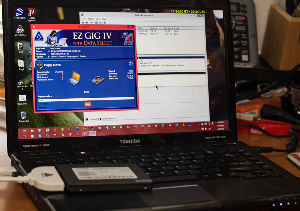 A call to Crucial support resulted in a suggestion that I plug the drive into my other computer (good thing I had one) to see if the drive was recognized there. It was. Then I formatted the solid-state drive (500GB in about 3 seconds) and moved it to the notebook computer. This time the notebook recognized the drive and so did EZ GIG 4. The application asked me to identify the source drive (a Hitachi drive inside the computer) and the destination drive (the Crucial SSD) and then reminded me to be sure the selection was right (it was) and, before the copy process started, it had me confirm the settings one more time.
A call to Crucial support resulted in a suggestion that I plug the drive into my other computer (good thing I had one) to see if the drive was recognized there. It was. Then I formatted the solid-state drive (500GB in about 3 seconds) and moved it to the notebook computer. This time the notebook recognized the drive and so did EZ GIG 4. The application asked me to identify the source drive (a Hitachi drive inside the computer) and the destination drive (the Crucial SSD) and then reminded me to be sure the selection was right (it was) and, before the copy process started, it had me confirm the settings one more time.
Having been on the wrong end of a disk format at least once, I appreciated the extra care that the developers took to make sure that A Very Bad Thing would not happen to the disk drive in the computer.
A bit more than 2 hours later, the cloning process was complete and it was time to swap in the new drive and swap out the old drive.
At this point the instructions are quite clear: Turn the computer off and do not reboot it with the new drive still attached. Doing this could cause some serious confusion. Before booting the computer, it's important to remove the old hard drive and install the new hard drive in its place.
Toshiba makes this relatively easy. Remove one screw, open the cover, slide the old drive to the right to disconnect it, lift it out, drop the new drive in, push it to the left to connect it, put the cover back on, and boot the system.
And Then?
Well, it worked. You were expecting me to have trouble here? To have some tale of woe?
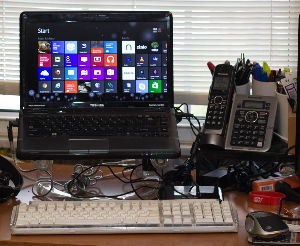 So was I, actually, but everything worked just the way it was supposed to. The new drive booted and all of the applications that needed to be authorized (Windows, the Office suite, Adobe applications, and such) were still authorized.
So was I, actually, but everything worked just the way it was supposed to. The new drive booted and all of the applications that needed to be authorized (Windows, the Office suite, Adobe applications, and such) were still authorized.
Pricing SSDs
Solid-state drives are still pricey. You'll pay around 80 cents to a dollar per gigabyte, compared to about 5 cents per gigabyte for standard drives. For example:
- A 120GB SSD sells for about $100 and if you can find a standard drive that small, you shouldn't pay more than about $30 for it.
- A 256GB SSD will cost around $200, compared to $60 for a standard drive of similar size.
- At 512GB, the SSD will cost around $400 and the standard drive about $85.
- Your wallet takes a real beating if you need a large SSD drive. A 1TB drive might cost $3000 compared to $100 for a standard drive.
- Standard drives are also available in even larger capacities: A 2TB drive sells for $125 to $150 and 4TB drives are commonly available for $170 to $250. Good luck finding any SSDs that large. And good luck paying for them if you do!
That’s why desktop owners who want the advantages that a solid-state drive will provide but aren’t independently wealthy select a smaller SSD on which they install the operating system and all applications. This gives the computer owner the fast-boot advantage and allows programs to start quickly but retains the lower price of standard drives for storing data. Unfortunately, that’s not an option for notebook computer owners. If you want a solid-state drive in a notebook, it’s an all-or-nothing proposition most of the time. A few specialty notebooks have two drive bays, so it would be possible to install one SSD and one standard drive. Or, if you use the notebook in a stationary location most of the time, to install the SSD for fast booting and to use an external standard drive for data.
Care and Feeding of SSDs
If you install a solid-state drive, you'll want to turn off disk defragmentation, or maybe you won't. Actually, it depends on which operating system you're using.
Anything before Windows 7 will try to defragment the SSD and that's not a good thing. Instead of helping make the drive faster, it can cause problems.
If you have Windows 7, the defrag process should be turned off by default.
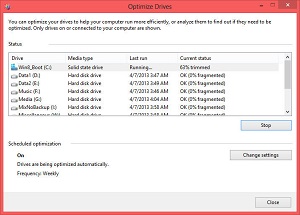 In Windows 8, defrag is turned on again and you might be inclined to turn it off. Don't. The media type will be shown as "solid state drive" and defragmentation will be enabled. That's because the process has changed in Windows 8. It's now a "general optimization tool" that capable of handling various kinds of storage. For SSDs, it sends what are called "trim hints" for the entire volume. That's because SSDs can be written at the byte level, but they need to erased at a block level.
In Windows 8, defrag is turned on again and you might be inclined to turn it off. Don't. The media type will be shown as "solid state drive" and defragmentation will be enabled. That's because the process has changed in Windows 8. It's now a "general optimization tool" that capable of handling various kinds of storage. For SSDs, it sends what are called "trim hints" for the entire volume. That's because SSDs can be written at the byte level, but they need to erased at a block level.
In plain English, that means that SSDs need to read hints from the file system so that they can reclaim partial blocks that are marked as occupied. When the Storage Optimizer detects an SSD, it sends trim hints for the entire volume when the drive is idle. So, for the most part, the operating system will get the settings right, but it's still a good idea to check it out.
Windows 8 is Why PC Sales Are Dropping, Right?
Wrong. What those who make this absurd claim miss is the fact that hardware is changing. Large numbers of users are migrating to portable devices instead of notebooks and to notebooks instead of desktops. How many people are simply waiting to see what devices are going to be available in the next 6 months or so before committing?
There's no question that PC sales are off and off dramatically. But saying that Windows 8 caused the decline is a long jump as conclusions go. The evidence just isn't there. There's no shortage of Windows 8 haters but these are the same people who hated Windows 7 and loved Vista and, before that, hated Vista and loved XP when Vista came out (by sheer luck, they got that one right.) Before Vista, they hated XP when it replaced Windows 2000. And ... well, you see the pattern here. Whatever was new is what they hated.
Windows 8 hasn't sold the way Microsoft hoped it would. As with most new hardware, the new devices are expensive. That said, I'm glad that I bought an Acer tablet because it fills a need I didn't know I had until I realized what the tablet would allow me to do. I mentioned that people are waiting and that's part of the reason why. Everybody knows that the first iteration of anything will cost too much. Apple has taught its users that many times by releasing something new and, six months later, releasing a nearly identical device with double the performance of the original and at two-thirds the price.
Windows 8 might have made the problem worse but it didn't cause the drop in sales. That particular handwriting has been on the wall for a long time. Had Microsoft hit a home run with Windows 8, the drop might not have been so severe, but there would have been a drop. We're in what's being called the post-PC era, a time when many people find that smart phones and other handheld devices give them all the computing power they need.
Apple invented the tablet and now that everyone is on board, it's clear that tablets are where sales are going to be.
Standard PCs continually become faster and more powerful. Disk space is cheap to buy, so computers come with more space. How many people do you know with 2 terabytes (2000 gigabytes) of storage space and 100 megabytes of data? In other words, these are people with disks that are 90% empty. And how many people need an 8-core CPU and 32GB of RAM to surf the Internet and check their e-mail? A tablet is more than sufficient for those tasks.
Desktop PCs won't be going away because there are still people who want to process high-end video, work on large photo files, and perform complex scientific calculations. But most PCs, even entry-level machines, have more power and storage than most people need. For pundits to pretend to be surprised that PCs sales drove over a cliff and then to name Windows 8 as the driving force for the crash is more than a little disingenuous.
The market for desktop computers (or at least notebooks) is likely to continue in the corporate world for a while. Anyone who spends all day in front of a computer entering data (or even just writing and replying to e-mail messages) isn't going to be very productive with a tablet. I see more and more business people who use desktop systems when they're at their desks with tablets in hand when they head for the conference room because tablets make outstanding reference devices and allow those who carry them to keep in touch with communications when they're in meetings.
So, yes, PC sales are down, this shouldn't be a surprise to anyone in the industry, and the decline was not precipitated by Windows 8.
Oh, and By the Way ...
Windows 8.1 (also known as Windows Blue) reportedly will include an option to bypass the Metro interface and go directly to the Desktop. I mean, after all, pressing the Windows key and "D" is apparently proving to be too difficult for some people.
I'm a bit conflicted about this. There's the "I told you so!" response (directed at Microsoft) from what I wrote a year ago. But there's also the "How lazy|stupid are you?" response directed at those who can't figure out how to use Windows 8. At this rate, Windows 8.2 (which will probably be code named "Green") will bring back the useless Start button so that the people who are complaining about the absence of the Start button can once again complain about the "idiocy" of using the Start button to shut down the computer.
Short Circuits
Microsoft Opens Its Campaign Against Amazon
So Microsoft is going to sell books? (Well, no.) They're going to create a competitor for the Kindle Reader? (No, but hasn't it already done that with Surface tablets?) Microsoft will set up an online store? (Not exactly.) So you might be forgiven for wondering what Microsoft would do that would be a threat to Amazon.
Besides the online retail presence, the books, and the reader, Amazon is a gigantic player in another area that many people don't know about: Providing support for websites owned by other people. Amazon Web Services offers hosting for prices ranging from free to a lot. Oh, by the way, "free" is good only for new customers and only for 12 months. After that, you'll pay.
Amazon Web Services is where Microsoft wants to challenge Amazon. AWS and other players in that segment of the market don't provide hosting for sites such as TechByter Worldwide. These services are for operations such as NASA and Nasdaq, The Guardian and LionsGate, Newsweek/The Daily Beast and Outback Steakhouse, and Instagram and Foursquare. In other words, operations that need to provide highly reliable service to a lot of people.
Microsoft would like a part of that action. In other words, they're going after a part of Amazon's operations that most people probably aren't even aware of.
Amazon knew that it needed a powerful computing platform to provide its own services and management (particularly Jeff Bezos) decided that if they had to build it, they might as well build it big enough to serve other companies and see if they could convert what would otherwise by an expense center into a profit center. So far, that has turned out well.
After testing its new service, Microsoft this week started selling the service and it will match Amazon's prices. But there's other competition. Although not exactly on par with Amazon, a company named Rackspace offers pricey and reliable hosting. And Google is, of course, in the cloud-based marketplace, too.
The cloud is a threat to Microsoft's traditional PC-based business and the company has moved quickly to make its Office suite relevant in a post-PC era. This is a stark difference from the company's stance in the 1990s when it seemed to believe that the Internet was nothing more than a passing fad. But the cloud is also an opportunity if Microsoft can take advantage of it, as it's attempting to do with operating systems and applications that play well on portable devices.
Oracle Says 42 Java Security Issues Have Been Resolved
42. That is, as you probably already know, "the answer to Life, the Universe and Everything." At least, you know that if you've read The Hitchhiker's Guide to The Galaxy by Douglas Adams. To avoid having writers like me introduce a story about their company in this silly way, Oracle should have added another bug or two to fix, even if they just had to invent one.
This week Oracle released patches to fix 42 vulnerabilities in Java and "the vast majority" of them were critical errors that represented significant security problems.
Oracle has a generally poor record of responding to security threats and several flaws have been used by cyber-criminals. One threat earlier this year, exposed computers that run Windows and computers that run Apple's OSX. Computers were infected inside some large organizations, including Apple and Facebook. The US Department of Homeland Security even issued a warning that suggested users disable Java until the problems could be fixed.
Some known bugs remain, but none are classified as "critical". By default, Java will now refuse to run any applications that have not been digitally signed. Users can override this setting and even criminals can obtain digital signatures for their malware, but this is at least a step in the right direction.
Who Turned off the Google?
Why is it news when a company has a problem that affects 0.007% of its users? When the company involved is Google. That happened this week when about half of Google's primary applications experienced some loss of service. And, yes, that number is 7 thousandths of one percent.
Things like this happen to everyone from time to time. TechByter Worldwide has been unavailable for short periods several times in the past few weeks because of distributed denial-of-service (DDoS) attacks against BlueHost, for example. Those outages are in no way connected with Google's problems on Wednesday.
No online service is immune. Apple's Icloud is unavailable sometimes. There have been times when Microsoft's TechNet has been unavailable. Even Amazon (the subject of an earlier report) sometimes suffers outages in its Amazon Web Service. And this week American Airlines had to ground all of its flights for part of a day because its Saaber online service wasn't online.
So Google experienced a small outage on Wednesday. Here's how to handle these kinds of disruptions: Sit quietly in front of your computer. Breathe deeply. Relax. If the problem persists, read a book or lie down with a cat.

